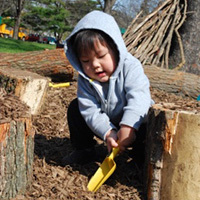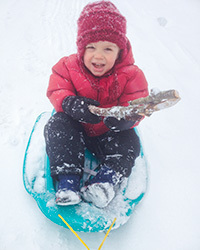 Being outdoors is great for kids. Studies summarized by the National Wildlife Federation show that kids who spend regular time playing outdoors are more likely to be:
- Great students and learners
- Able to get along well with others
- More creative and curious
- Good problem solvers
- Generally healthier and happier overall!
As a parent of two young boys, I can also tell you that nature play is relaxing and fun! Here are the basics, as well as some great resources to get you started.
Authentic nature play is unstructured, imaginative, and open-ended. It encourages experimentation and observation. It also includes an element of age-appropriate risk-taking. Risk taking can be as simple as climbing, balancing, and jumping from a new height.
While away-from-home nature areas might create some wonderful memories, you don’t have to travel away from your home to get the benefits of nature play. With a few simple additions, a backyard can include lots of the “good stuff” that is a part of nature play.
|
 Nature play at home can include things like:
- Loose parts, like piles of rocks, sticks, or leaves
- Construction materials, like sticks, poles, straw bales, tarps, boxes, and 2x4s
- Tools, like shovels, buckets, and rope
- Water
- Mud, dirt, or sand
- Hiding spaces
- Plants
- Balance logs and stumps
- Small characters or props for ‘fairy villages’
- Swings, hammocks, and other places for relaxing
One of the most inspirational guides I’ve read about nature play at home is the National Wildlife Federation's guide for Nature Play at Home. Every time I look at it, I get new ideas! You can also find great resources on the Minnesota DNR’s Arbor Month page.
There
are small adjustments to be made as you let your kids play in this way.
For example, I’ve learned not to worry when the sand leaves the sand
box. I’ve decided to allow the kids to dig a big hole in the yard, but I
chose where to let it happen. I’ve let the kids harvest 'herbs' as a
part of their imaginative games even if it means some of my plants take a
beating. And, as the parts, pieces, forts, and rock piles move around
it is certainly a bit messier than my pre-kid yard, but not any messier
than most of my life. I smile (and take a seat on the porch steps) when I
see how engaged and focused my sons and their friends can be in this
environment.
Small spaces work too
Remember,
even when space is limited there are creative nature play ideas to
adopt. Balconies are usually big enough for potted plants, a fairy
village, a vine tee pee growing out of pots, or a small sand box.
Ideas for winter
Snow
play is a wonderful form of nature play. Mittened hands can still play
with loose parts, branches, stumps and ropes. When the cold brings you
in, bring nature play inside:
- Bring
loose parts inside. Fill baskets with rocks, tree slices, leaves,
acorns, and other things you collect. They can be used as props for any
storyline your young ones create.
-
Make an indoor sandbox.
- Bring snow inside in a tub to play with. Try painting it with watercolors, like this.
|
The Eco
Experience at the Minnesota State Fair will include a nature adventure
play area this year, installed by Fireflies Play Environments, Inc. and
Aloha Landscaping. Give your kids some unstructured time in the area
while you learn about the exhibit partners, local organizations that support and provide
nature play, including:
Join your East Side St. Paul neighbors for the Urban Oasis Food Fest, a free community food festival. Watch a tomato-canning demonstration, gather menu ideas, and sample treats from East Side food vendors, August 17, noon–4 p.m., 740 Seventh Street East (St. Paul).
Taking care of your trees benefits air quality, water quality, the urban heat island effect, property values, and more. Learn how to get your trees ready for winter and talk trees with other
interested folks, September 13, 1-3 p.m. (drop in), Maplewood Nature Center.
Installing a rain barrel is a simple, powerful way to protect our local waters.
Join the Friends of the Mississippi River for a make-and-take rain barrel workshop, September 25, 6-7:30 p.m., Lakeville Area Arts Center.
Thank you for reading Living
Green 365. This newsletter is a publication of the Minnesota Pollution Control
Agency. Please send questions or comments about living green to the address
below.
Sincerely,
Britt Gangeness and the Living Green Team
livinggreen365.pca@state.mn.us
|